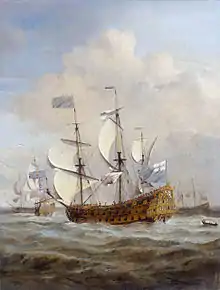Willem van de Velde the Younger
Willem van de Velde the Younger (18 December 1633 (baptised) – 6 April 1707) was a Dutch marine painter, the son of Willem van de Velde the Elder, who also specialised in maritime art.
Willem van de Velde the Younger | |
|---|---|
_-_(by_Lodewijk_van_der_Helst%252C_1672).jpg.webp) Portrait of Van de Velde in 1672 by Lodewijk van der Helst | |
| Born | 18 December 1633 (baptised) |
| Died | 6 April 1707 (aged 73) |
| Nationality | Dutch |
| Known for | Marine painting |
Biography
Willem van de Velde was baptised on 18 December 1633 in Leiden, Holland, Dutch Republic.
A son of Willem van de Velde the Elder, also a painter of sea-pieces, Willem van de Velde, the younger, was instructed by his father, and afterwards by Simon de Vlieger, a marine painter of repute at the time, and had achieved great celebrity by his art before he came to London.[1] He was also influenced by the work of the Dutch maritime artist Jan van de Cappelle, who excelled at painting cloudy skies, the clouds often being reflected in the calm waters. The younger Van de Velde collaborated with his father, an experienced draughtsman, who prepared studies of the battles, events and seascapes while the son painted the pictures. Father and son were driven from the Netherlands by the political and economic conditions which resulted from war with the French, and by 1673, had moved to England.[2] Here he was engaged by Charles II, at a salary of £100, to aid his father in "taking and making draughts of sea-fights", his part of the work being to reproduce in color the drawings of the elder Van de Velde. He was also patronized by the Duke of York and by various members of the nobility.[1]
He died on 6 April 1707 in London, England,[1] and was buried at St James's Church, Piccadilly. A memorial to him and his father lies within the church.

His brother, Adriaen van de Velde, was also an artist.
Works
.jpg.webp)
.jpg.webp)
Most of Van de Velde's finest works represent views off the coast of Holland, with Dutch shipping. His best productions are delicate, spirited and finished in handling, and correct in the drawing of the vessels and their rigging. The numerous figures are tellingly introduced, and the artist is successful in his renderings of sea, whether in calm or storm.[1] The ships are portrayed with almost photographic accuracy, and are the most precise guides available to the appearance of 17th-century ships.
Substantial collections of Van de Velde's paintings and drawings are held in the National Gallery,[4] National Maritime Museum[5] and the Wallace Collection,[6] all in London; the Rijksmuseum[7] in Amsterdam; and the National Gallery of Art[8] in Washington DC.
Gallery
%252C_by_Godfrey_Kneller_MUS-FAFP1114.jpg.webp) Portrait of van de Velde, by Godfrey Kneller
Portrait of van de Velde, by Godfrey Kneller The Battle of Texel, painted 1687
The Battle of Texel, painted 1687 The burning of the Royal James at the Battle of Solebay
The burning of the Royal James at the Battle of Solebay HMS St Andrew at sea in a moderate breeze, painted c. 1673
HMS St Andrew at sea in a moderate breeze, painted c. 1673.jpg.webp) Ships riding quietly at anchor c. 1670s
Ships riding quietly at anchor c. 1670s The English Ship Hampton Court in a Gale c. 1680s [9]
The English Ship Hampton Court in a Gale c. 1680s [9] Calm: Fishing Boats Under Sail c. 1655-60
Calm: Fishing Boats Under Sail c. 1655-60 Entrance to a Dutch Port, c. 1665, Metropolitan Museum of Art
Entrance to a Dutch Port, c. 1665, Metropolitan Museum of Art
References
- Chisholm 1911.
- Bisanz-Prakken, Marian; van Rijn, Rembrandt Harmenszoon (2005). Rembrandt and His Time: Masterworks from the Albertina, Vienna. Hudson Hills. p. 204. ISBN 978-1-55595-257-0.
- "Dutch Ships in a Calm Sea, Willem van de Velde (II), c. 1665". Rijksmuseum. Retrieved 12 May 2020.
- "Willem van de Velde (1633 - 1707)". National Gallery. Retrieved 14 May 2020.
- "Artist profile: Willem van de Velde (Elder and Younger)". Royal Museums Greenwich. 2 September 2015. Retrieved 14 May 2020.
- "Wallace Collection Online - van de Velde the Younger Willem van de Velde the Younger". wallacelive.wallacecollection.org. Wallace Collection. Retrieved 14 May 2020.
- "Search in Rijksstudio, Name: Willem van de Velde (II)". Rijksmuseum. Retrieved 14 May 2020.
- "Willem van de Velde the Younger". National Gallery of Art. Retrieved 14 May 2020.
- The English Ship Hampton Court in a Gale Birmingham Museums
 This article incorporates text from a publication now in the public domain: Chisholm, Hugh, ed. (1911). "Vandevelde, William". Encyclopædia Britannica. 27 (11th ed.). Cambridge University Press. p. 887.
This article incorporates text from a publication now in the public domain: Chisholm, Hugh, ed. (1911). "Vandevelde, William". Encyclopædia Britannica. 27 (11th ed.). Cambridge University Press. p. 887.
External links
| Wikimedia Commons has media related to Willem van de Velde. |
- Works by or about Willem van de Velde the Younger in libraries (WorldCat catalog)
- 182 paintings by or after Willem van de Velde the Younger at the Art UK site
